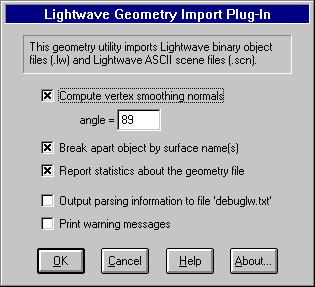 Lightwave Geometry Import Converter
Lightwave Geometry Import Converter Lightwave Geometry Import Converter
Lightwave Geometry Import ConverterThis geometry import converter reads in Lightwave binary object files (.lw) and ASCII scene files (.scn). In addition to its basic import capabilities, the converter can also reconstruct scene hierarchy using information gleamed from the scene file and accurately create texture coordinates for the object data from the input texture projections.

A nice feature of the converter is that it will use object instancing to reduce the size of the imported scene. For example, if the Lightwave scene file references a Lightwave object 10 times then the converter will only read in and store the basis geometry for the referenced object once. All other references to the file will create instances of the object (in other words, "virtual" objects); this is a benefit of the object/instancing capabilities of the converter's internal database.
As some background information, Lightwave uses two types of files to describe a scene:
Note that if an object has more than one surface applied to it then the converter will explode the object into separate pieces, each with a single surface assigned to it.